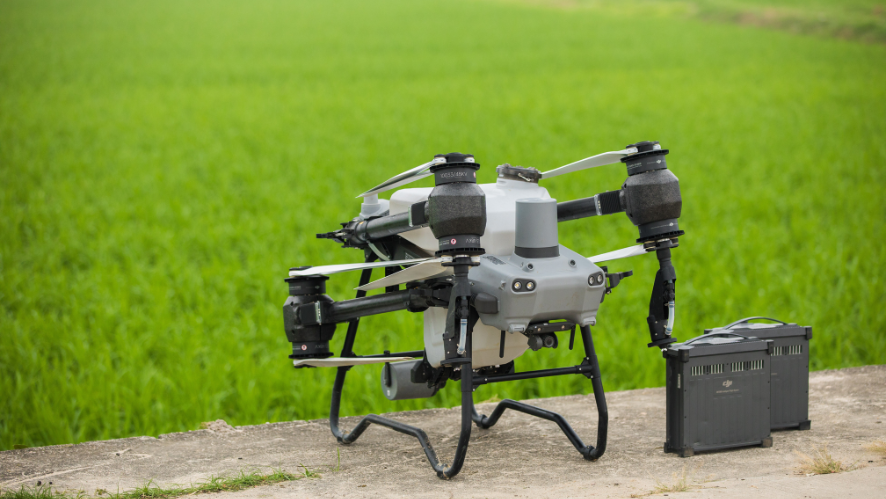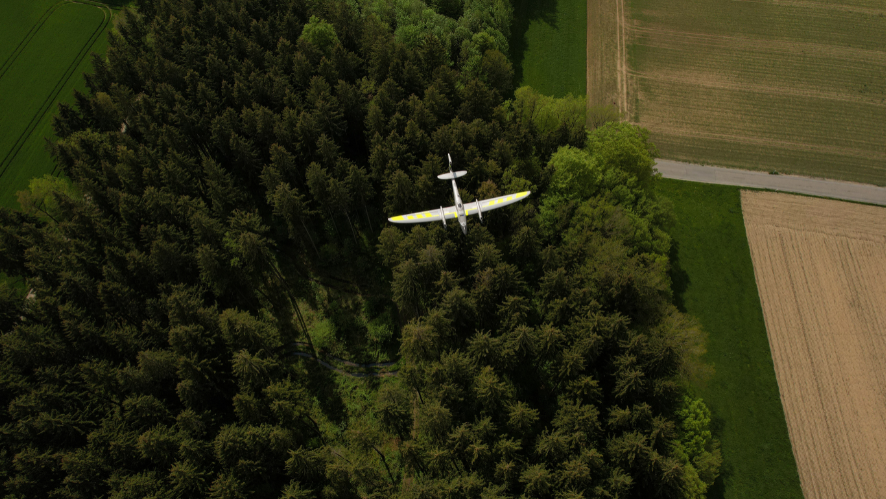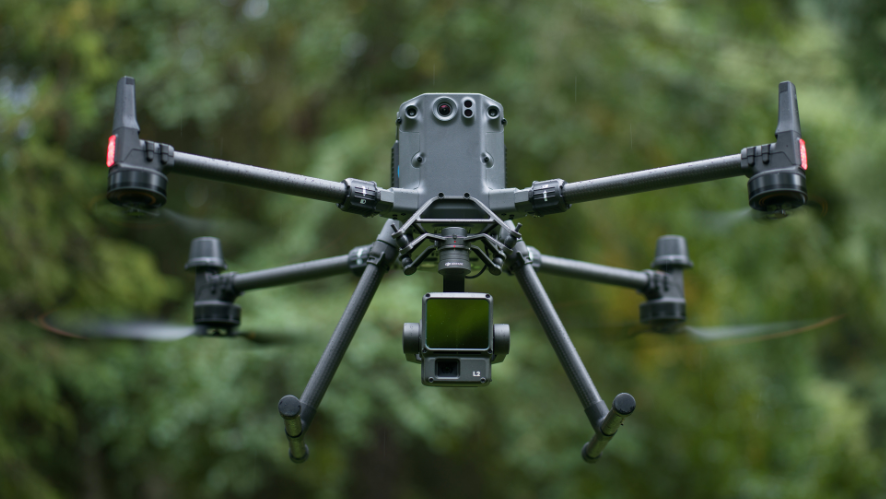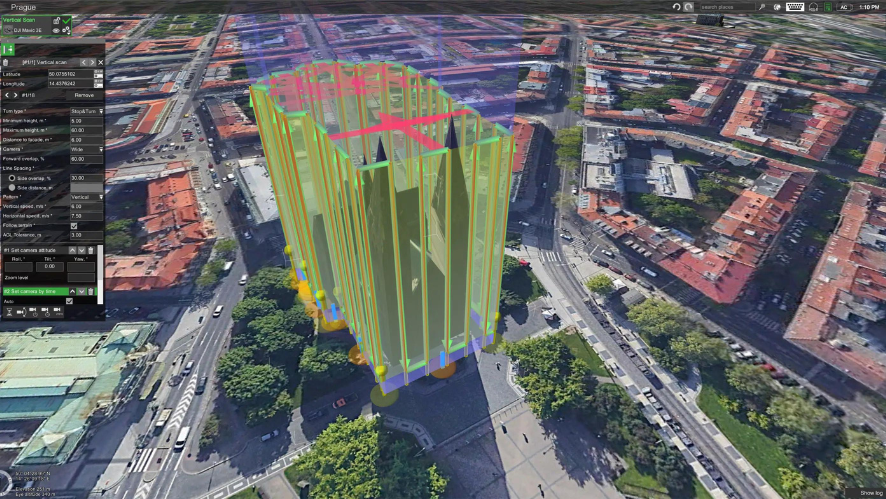The DJI FlyCart 30 is DJI’s first delivery drone (DJI Delivery). This drone was designed for the most challenging and demanding scenarios, such as emergency delivery, mountain logistics, maritime-maritime transport or any situation requiring the transport of heavy cargo over difficult terrain.
Learn more about the main features of this innovative equipment.
DJI FlyCart 30 can carry 30 kg, but also 40 kg.
When used with a single battery, the FlyCart 30 drone has a maximum carrying capacity of 40 kg. However, it can only fly for a maximum of 9 minutes and a maximum distance of 8 kilometers in single battery configuration. We only recommend it for emergency situations where a lot of material needs to be transported quickly.
It supports both single and dual battery configurations.
We recommend flying with both batteries because if something goes wrong and a single battery fails, the other battery can sustain the flight for a safe landing. However, with a single battery, the drone is lighter and can carry a heavier payload. The pilot may think of it as a trade-off between payload capacity versus flight time and distance.
The batteries weigh approximately 11.3 kg each.
Each DB2000 battery has a capacity of 38,000 mAH and is rated to operate at temperatures between -20° and 45°C. They are hot-swappable and self-heating, so they are ready to operate even in cold environments. The DB2000 batteries are charged with the DJI C8000 smart charger, which can charge two batteries at the same time. A single battery takes 26.5 minutes to charge, while two batteries together can be charged in 36.6 minutes. The DB2000 batteries are guaranteed for 1,500 charge cycles or 12 months of operation, whichever comes first.
It can transport goods up to 16 kilometers (10 miles) away.
This is achieved with two fully charged batteries and a payload of 30 kg. With a lighter payload, it can fly even farther. Without payload, the drone can fly 28 kilometers.
It can fly continuously on one set of batteries for 18 minutes.
This is measured with a total payload of 30 kg. If you need to carry more weight in a situation
It has a maximum flight altitude of 6,000 meters (20,000 feet).
The payload capacity of the DJI FlyCart 30 decreases as the takeoff altitude increases. 6,000 m is the maximum safe altitude when flying in dual battery mode with no payload. With a total payload of 30 kg, the maximum safe altitude is 3,000 m (10,000 ft).
It is designed for adverse weather conditions.
It is IP55 rated and corrosion resistant, can withstand temperatures from -20° to 45° C and fly in winds up to 12 m/s. This equates to 43 km/h or 26.8 mph. Built to ensure that deliveries arrive safely, even in harsh environments.
DJI FlyCart 30 is flexible with SDK.
Through DJI’s Payload SDK, developers can create third-party payload systems on the DJI FlyCart 30.
Supports Charge Mode.
This is the standard configuration of the drone, where payloads are placed inside a cargo box. The cargo box is made of EPP and has a metal frame. When the drone lands, the box can be opened and the payload retrieved. Thanks to weight and center of gravity detection, it can ensure a balanced payload for safe and stable flight. The payload bag has a volume of 70 liters and the following internal dimensions: 573 x 416 x 305 mm (LxWxH).
Supports winch mode
The winch system kit is sold separately, but is perfect for deliveries in areas without clear or stable landing sites. This alternative to Cargo mode allows the drone to lower the payload and automatically release the package when it touches the ground, rather than landing. The winch cable is 20 meters long and can descend or retract at 0.8 m/s. The winch grapple can support a maximum payload of 40 kg and can release the load automatically or manually when it contacts the landing site. During flight, if the suspended payload starts to sway, the DJI FlyCart 30 can stabilize itself with Swing Control, an intelligent function that automatically adjusts the drone’s attitude to minimize sway. This feature saves battery life and also improves overall flight safety.
DJI FlyCart 30 can cut its own winch cable.
This safety feature is provided in case the suspended load becomes entangled or stuck, for example, in a tree canopy or in the branches below. If one of these situations occurs, the pilot will receive a warning on the remote control with the Cut Cable function, which uses heat to cut the winch cable. This frees the drone and allows it to fly safely. Before cutting the cable, make sure the area directly below the drone is safe and unoccupied.
DJI FlyCart 30 features Dual Active Phased Array radars.
These two radars constantly scan the drone’s surroundings during takeoff, flight and landing. One radar is at the top front of the drone, while the other is at the bottom rear, providing multi-directional detection capabilities. They have a horizontal detection range of 1.5 to 50 meters and vertical detection range of up to 200 meters. Combined with the binocular vision system, they enable intelligent obstacle detection.
DJI FlyCart 30 features a dual binocular vision system.
These sensors placed on the front of the drone have a 90° horizontal FOV and 106° vertical FOV and work in sync with the drone’s radar systems to enable intelligent obstacle detection.
Supports real-time terrain detection.
With radar and binocular vision systems, the DJI FlyCart 30 can detect the terrain below, provide the drone’s distance to the ground in real time, and automatically adjust flight speed to avoid the ground. This improves the safety and efficiency of operations.
It has layers with multiple redundancies.
It has backups of all critical systems and sensors. One example is the dual battery configuration, so that if one fails, the other can take over. The same goes for integrated dual IMUs, barometers, RTK antennas, radars, binocular sensors and other components.
DJI FlyCart 30 supports pre-programming of alternate landing sites.
During a delivery flight, if conditions change and the drone calculates that its original destination is inaccessible, it can safely land at an intermediate alternate landing site. Therefore, have a backup plan.
It has an integrated parachute for emergency landings.
If the drone has a critical error, the nylon parachute will automatically deploy and land the drone safely. The parachute has its own self-test at startup and an independent power supply. Prior to launch, the FlyCart 30 will stop the rotation of the propellers so as not to contact the parachute. It requires a minimum altitude of 60 meters to deploy and can safely land the drone at a terminal descent rate of 6 m/s when the total weight of the drone together with the payload is less than or equal to 95 kg.
It has a high resolution FPV gimbal camera.
With a resolution of 1920×1440 and a frame rate of 30 fps, the FPV camera is on a single-axis gimbal. This helps pilots and operators see the drone’s surroundings, improving situational awareness and flight safety.
It has O3 video transmission up to 20 kilometers.
It is powered by the drone’s four antennas on dual 2.4 GHz/5.8 GHz bands. This means you can see crisp, clear video images from the drone as it flies, for improved situational awareness and flight safety.
It is controlled by DJI RC Plus and DJI Pilot 2.
It has a 7-inch high-brightness display, customizable buttons and IP54 protection. The control software is DJI Pilot 2, which displays flight status, charging status and other real-time interactive interfaces for efficient and safe operations.
Supports dual operator mode
Two pilots, each with their own remote control, can work together to operate the drone. Control permissions can be conveniently transferred from one pilot to another, allowing flexible operations over long distances.
Can follow fully automatic pre-programmed flight paths
Flight routes can be planned with DJI Pilot 2 and managed with DJI DeliveryHub. Even if pilots have to be attentive to the control knobs, it will save them a lot of effort for repetitive operations-very repetitive, this saves a lot of effort.
DJI FlyCart 30 can be managed and organized with DJI DeliveryHub
DeliveryHub is a complete air delivery management platform that can help you plan deliveries, monitor the status of ongoing deliveries, assign tasks to your team members, and collect and analyze delivery data. It is compatible with various types of devices, from computers to phones to remote controllers. Together with DJI Pilot 2, it’s all you need to successfully operate the DJI FlyCart 30.
_________________________________________________________________________________________________________________
|
|











